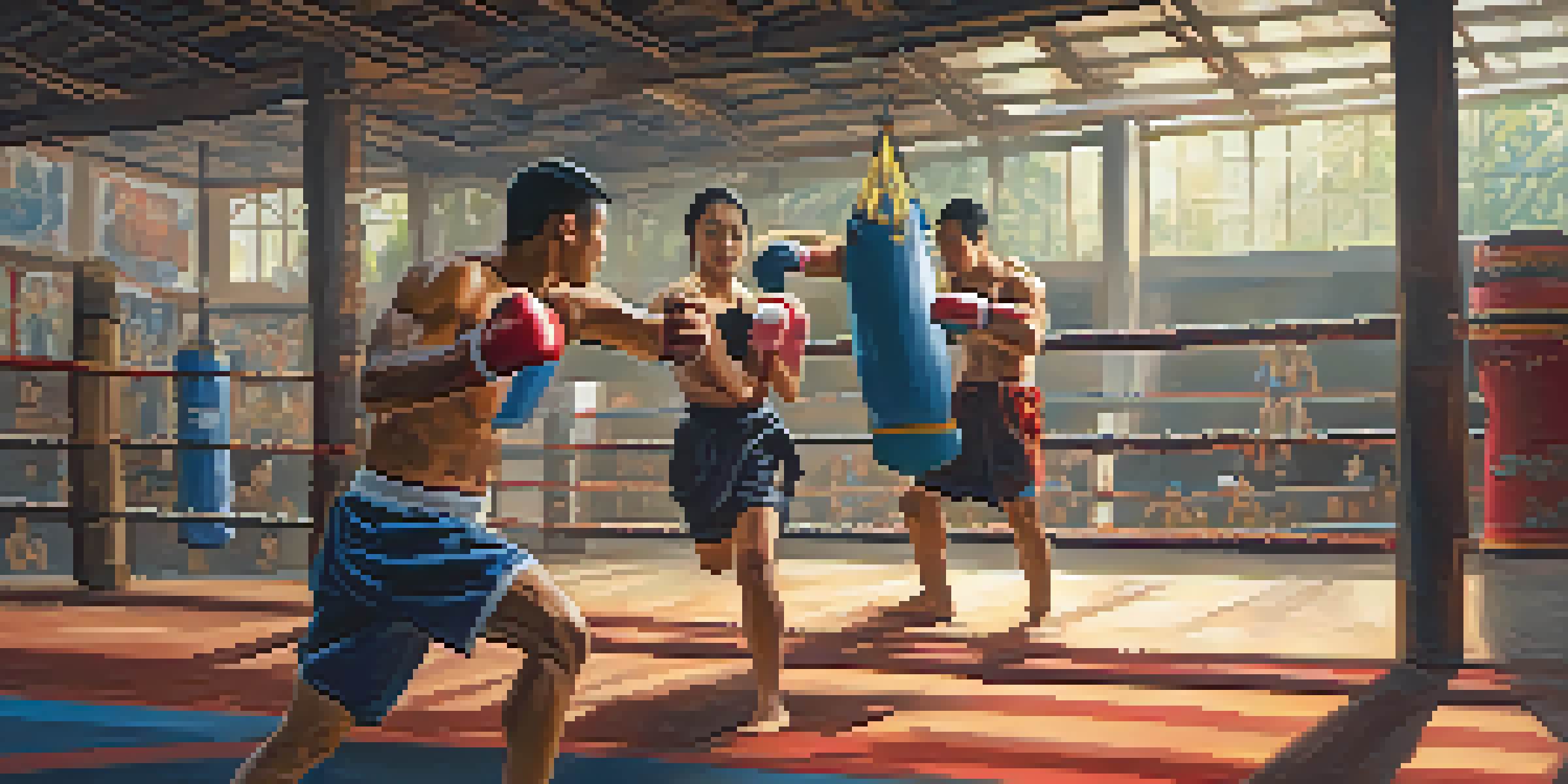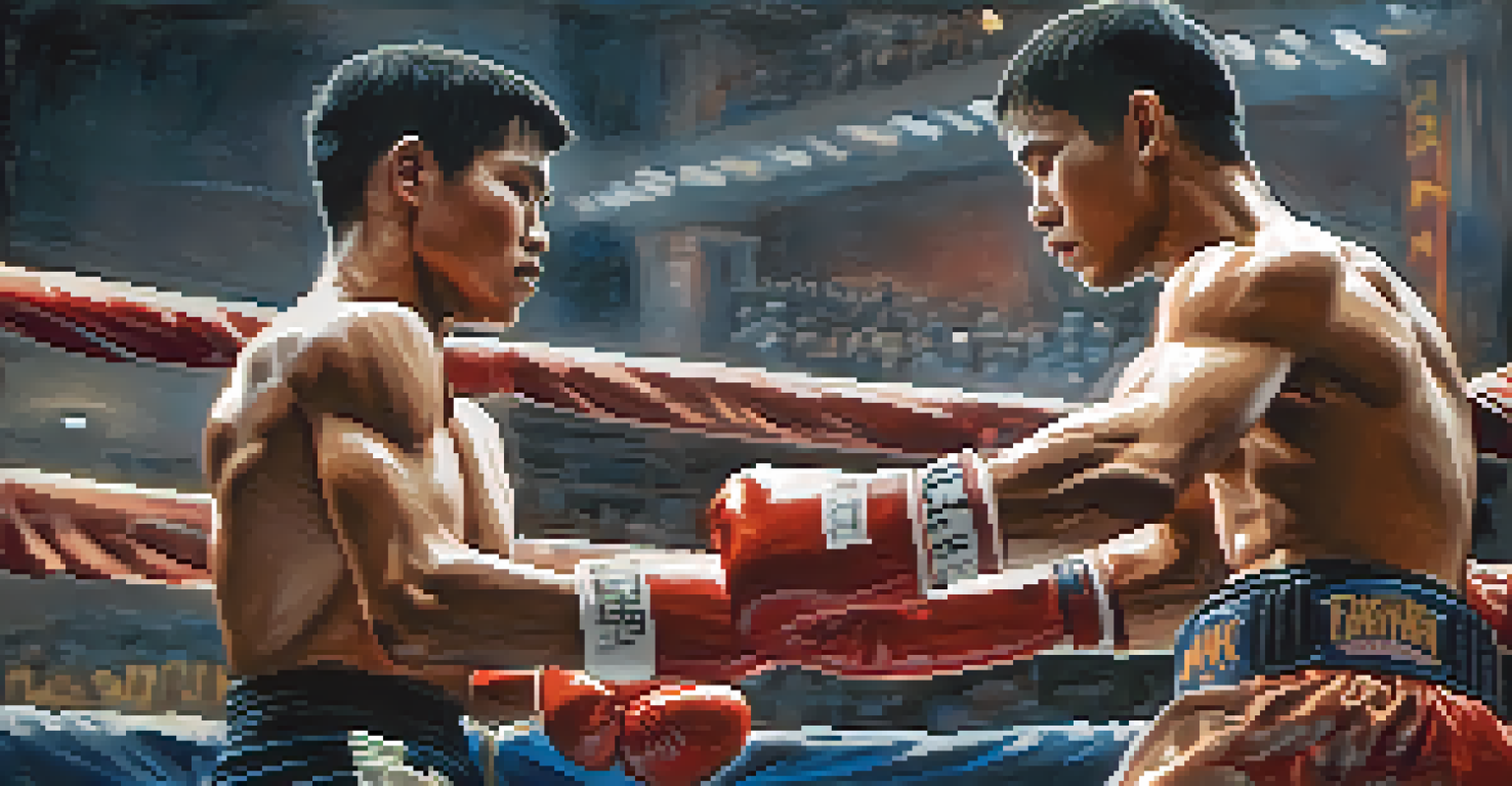Muay Thai: The Art of Eight Limbs and Its Cultural Roots

Understanding Muay Thai: The Art of Eight Limbs
Muay Thai, often referred to as the Art of Eight Limbs, is a striking martial art that utilizes punches, kicks, elbows, and knees. This unique combination of techniques allows practitioners to engage their entire body in combat, making it a versatile and effective form of self-defense. The term 'eight limbs' refers to the eight points of contact used in striking, which sets it apart from other martial arts that may rely more on punches and kicks alone.
Muay Thai is not just a sport; it’s a way of life, a philosophy that brings out the best in each individual.
Originating from Thailand, Muay Thai is not just a sport but a deep-rooted cultural tradition. It has evolved over centuries, with its history intertwined with the military training of Thai warriors. These warriors developed techniques that would eventually form the basis of Muay Thai, showcasing the art's practical applications in warfare as well as its sporting elements.
For many, practicing Muay Thai is an exhilarating experience that builds physical strength and mental discipline. The rhythm of the training sessions often resembles a dance, where each technique flows seamlessly into the next, creating a beautiful display of power and grace.
The Historical Roots of Muay Thai
The history of Muay Thai can be traced back to the 16th century, during the reign of King Naresuan, when it was practiced by soldiers to prepare for battle. As these warriors trained, they developed not only fighting techniques but also rituals and traditions that are still honored today. This rich history is reflected in the way Muay Thai is practiced, with respect and reverence for its origins.

Over the years, Muay Thai transitioned from a battlefield skill to a sport. The introduction of rules and the establishment of formal competitions helped it gain popularity, both in Thailand and internationally. Traditional elements, such as the Wai Khru ritual, remain integral to Muay Thai, emphasizing the respect practitioners have for their teachers and the art itself.
Muay Thai: A Cultural Heritage
Originating from Thailand, Muay Thai is not just a martial art but a deep-rooted cultural tradition with rich historical significance.
In modern times, Muay Thai has gained recognition as a professional sport, with athletes competing in prestigious events worldwide. This evolution has not diminished its cultural significance; instead, it has provided a platform for the art to reach new audiences while preserving its historical roots.
Techniques and Training in Muay Thai
Training in Muay Thai typically involves a mix of cardio, strength, and skill development. A typical session might include shadow boxing, pad work, and sparring, allowing practitioners to hone their techniques while improving their physical fitness. This multifaceted approach ensures that students not only learn the art but also build endurance and resilience.
The ultimate aim of martial arts is not having to use them.
The striking techniques in Muay Thai are diverse, utilizing the fists, elbows, knees, and shins. Each technique is designed for specific situations, whether that be delivering a powerful kick or executing a quick elbow strike in close quarters. This variety keeps training engaging and helps practitioners adapt to different fighting scenarios.
Moreover, the mental aspect of training is just as crucial as the physical. Muay Thai encourages practitioners to develop focus, discipline, and strategy, which are essential attributes both inside and outside the ring. This holistic approach to training makes Muay Thai appealing to individuals seeking personal growth along with physical fitness.
Cultural Significance of Muay Thai in Thailand
Muay Thai is often referred to as Thailand's national sport, reflecting its deep cultural significance. It is woven into the fabric of Thai society, celebrated in festivals and featured prominently in local events. The sport is not just about competition; it's a source of national pride and a way to showcase Thai heritage on the global stage.
In addition to its status as a sport, Muay Thai is also seen as a form of art. The rituals and traditions surrounding it, such as the ceremonial dance known as the Wai Khru, highlight the respect for teachers and the lineage of techniques passed down through generations. These elements create a strong sense of community among practitioners, enriching the cultural experience.
Holistic Benefits of Training
Practicing Muay Thai offers physical fitness, stress relief, and fosters strong social connections among practitioners.
The appeal of Muay Thai extends beyond the borders of Thailand, attracting enthusiasts from around the world. As people train in this martial art, they not only learn self-defense but also gain insight into Thai culture, fostering an appreciation for its history and values.
Muay Thai in the Modern World
Today, Muay Thai has transcended its traditional roots to become a global phenomenon. It is practiced in gyms and studios across the world, appealing to a diverse audience. Many individuals are drawn to it for fitness, self-defense, or simply the thrill of learning a new skill, illustrating its versatility as a martial art.
The rise of mixed martial arts (MMA) has also contributed to the popularity of Muay Thai techniques. Fighters often incorporate Muay Thai striking into their training regimes, recognizing its effectiveness in combat sports. This crossover has helped elevate the profile of Muay Thai, attracting even more practitioners eager to learn its techniques.
Despite its global reach, the essence of Muay Thai remains rooted in its cultural traditions. Many gyms that teach Muay Thai emphasize the importance of respecting its history and values, ensuring that new practitioners appreciate the art's rich heritage while embracing its modern applications.
Health Benefits of Practicing Muay Thai
Engaging in Muay Thai offers numerous health benefits, making it a popular choice for fitness enthusiasts. The intense physical activity involved in training can lead to improved cardiovascular health, increased strength, and enhanced flexibility. As practitioners learn to strike and defend, they inadvertently build muscle and stamina, which contribute to overall fitness.
Additionally, Muay Thai is excellent for stress relief. The focus required during training sessions allows individuals to channel their energy and frustrations into productive outlets. Many practitioners find that the rhythm of training combined with the physical exertion helps to clear their minds and boost their mood.
Modern Appeal of Muay Thai
Today, Muay Thai is a global phenomenon, attracting enthusiasts for fitness, self-defense, and as a key element in mixed martial arts.
Moreover, the sense of community within Muay Thai training environments fosters strong social connections. Practitioners often form friendships through shared experiences, creating a supportive network that encourages personal growth. This camaraderie adds another layer of benefit to practicing Muay Thai, enhancing both mental and emotional well-being.
Conclusion: Embracing the Art of Eight Limbs
In conclusion, Muay Thai is much more than just a martial art; it is a rich tapestry of culture, history, and personal growth. Its unique techniques, steeped in tradition, offer practitioners a holistic approach to fitness and self-defense. As Muay Thai continues to evolve, it carries with it the spirit and values that have defined it for centuries.
Whether you are drawn to Muay Thai for its physical benefits, its cultural significance, or the thrill of combat, it provides an opportunity for individuals to connect with themselves and others. Embracing this art form allows practitioners to not only learn effective striking techniques but also to appreciate the depth of its heritage.

As you explore the world of Muay Thai, remember that each kick, punch, and knee strike is a tribute to the tradition and community that has shaped it. So, step onto the mat with respect and enthusiasm, and immerse yourself in the transformative journey that is the Art of Eight Limbs.